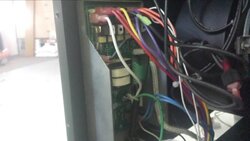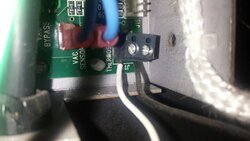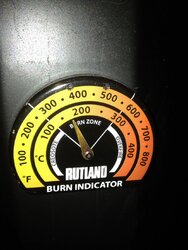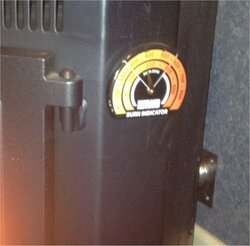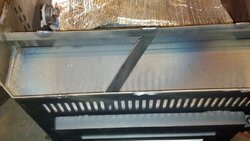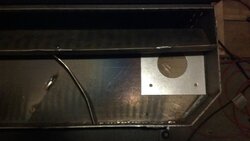I, had the same problem with 1 of my 25 PDVC stoves blowing cold on one side. I, have one stove I,bought back in '08 no issues with heat output, auger jams or anything really. I, then bought a second one for my basement in 2010 that had a manufacture date of 06/2009 which had this problem as well as major upper auger jams frequently. This is what I, noticed, if you look thru the top where the heat blows out, inside there is a plate that is welded at an angle. I, would say this some how diverts the air coming from the blower fan to scavenge the heat off the exchanger. What I noticed was that the one I have that was made in '08 the plate was welded in pointing in a different direction than the one from 2010. I, ended up taking the hopper out and cutting the welds that hold the top plate on the stove to gain access to this plate. I, cut the divert-er plate and reinstalled it in the same fashion as the one from '08. Now I get the heat coming out the front like it should. Cutting the welds was a pain especially the ones in the back where the hopper sits. I, used a Dremel with a Carbide Burr to thin the welds down then broke them with a hammer and chisel. It was a little work to get at but it drove me nuts that I was not getting the heat output like I should.
I, just recently got the auger jam issue fixed after trying everything. Even called Englander a while back great guys but, was no real help in solving my problem. One thing they suggested was to change pellets but, that theory didn't hold with me cause I had no problems with my other stove running any kind of pellet. I, deburred the auger, aligned everything, cleaned everything even bought new auger and motor. Sometimes it would run for 2 weeks not problem other days I wanted to put a sledge hammer to it. About 4 weeks ago 5 jams in one day I was at my wits end. Some where that night I started reading on here of course something about the jam taking place at the drop chute to the lower auger. I, never even thought to look at this as being an issue always focusing my attention to the top auger. I, pulled the lower auger and noticed the drop chute got narrow at the bottom where it extends down to the lower auger. The angle for drop ramp also seemed to kind of flatten out where it transitions in to the lower auger.
I, figured lets open this up and see what happens after going to Lowes and buying the snake attachment for the Dremel and some burrs and grinding stones 6 hours later this thing was ported smooth and bored out. I, even hacked out the part in the casting on the drop ramp that flattened off probably about 3/16". I, put it back together and 4 weeks later no jam up I've even put a hand full of sawdust right in to the auger with the hopper empty to simulate the problem with the "fines" to try and jam it.Still going. Not sure if any of this will help but these were some of my issues and what I did to solve them. Finally I got 2 "decent" working stoves I, was really disappointed with my second stove and put a lot of effort into it to getting it to work right. I'm not going to blast Englander stoves I, like the product for what it is but, have noticed that looking at the 2 stoves I, have in comparison their quality on fit and finish went down ( just my opinion with the ones I have).


